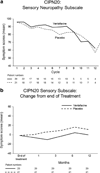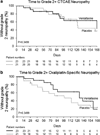MC11C4: a pilot randomized, placebo-controlled, double-blind study of venlafaxine to prevent oxaliplatin-induced neuropathy
- PMID: 26248652
- PMCID: PMC4939800
- DOI: 10.1007/s00520-015-2876-5
MC11C4: a pilot randomized, placebo-controlled, double-blind study of venlafaxine to prevent oxaliplatin-induced neuropathy
Abstract
Purpose: Previous pilot data suggested that venlafaxine could prevent acute and chronic oxaliplatin-related neuropathy. The purpose of this randomized, placebo-controlled, double-blinded pilot study was to obtain additional data to support conducting a phase III trial to test the use of venlafaxine to prevent oxaliplatin neurotoxicity.
Methods: Fifty patients, scheduled to undergo oxaliplatin-based therapy (FOLFOX) for stages II-III (67%) or stage IV (33%) colon cancer, were randomized to receive venlafaxine extended release (37.5 mg) or placebo, twice daily, through their last dose of oxaliplatin and then titrated off. Neurotoxicity was evaluated via several patient- and physician-reported measures, including the European Organization for Research and Treatment of Cancer Quality of Life Questionnaire-Chemotherapy-Induced Peripheral Neuropathy 20 (EORTC QLQ-CIPN20) instrument.
Results: Baseline patient characteristics were equivalent for the two arms, with a median age of 60 years. There was a trend toward benefit for the venlafaxine arm, when evaluated by the oxaliplatin-specific neuropathy scale and by acute neuropathy measures of throat discomfort and discomfort swallowing cold liquids, the latter only for the first two oxaliplatin doses. These trends were outweighed by a lack of any such trends in all other measurements including the following: (1) the CIPN20 sensory subscale (P = 0.55, primary endpoint), physician-completed NCI CTCAE assessment, or cumulative administered oxaliplatin doses (median 716 vs 631 mg for placebo and venlafaxine, respectively, P = 0.34).
Conclusions: The present study neither supports the use of venlafaxine for preventing oxaliplatin-induced neuropathy in clinical practice nor the initiation of a phase III trial to investigate venlafaxine in this setting.
Trial registration: ClinicalTrials.gov NCT01611155.
Keywords: Chemotherapy-induced neuropathy prevention; Venlafaxine.
Conflict of interest statement
Figures






Similar articles
-
Phase III randomized, placebo-controlled, double-blind study of monosialotetrahexosylganglioside for the prevention of oxaliplatin-induced peripheral neurotoxicity in stage II/III colorectal cancer.Cancer Med. 2020 Jan;9(1):151-159. doi: 10.1002/cam4.2693. Epub 2019 Nov 13. Cancer Med. 2020. PMID: 31724334 Free PMC article. Clinical Trial.
-
Efficacy of venlafaxine for the prevention and relief of oxaliplatin-induced acute neurotoxicity: results of EFFOX, a randomized, double-blind, placebo-controlled phase III trial.Ann Oncol. 2012 Jan;23(1):200-205. doi: 10.1093/annonc/mdr045. Epub 2011 Mar 22. Ann Oncol. 2012. PMID: 21427067 Clinical Trial.
-
Comparative study of the effects of venlafaxine and duloxetine on chemotherapy-induced peripheral neuropathy.Cancer Chemother Pharmacol. 2018 Nov;82(5):787-793. doi: 10.1007/s00280-018-3664-y. Epub 2018 Aug 13. Cancer Chemother Pharmacol. 2018. PMID: 30105459 Clinical Trial.
-
Platinum-induced peripheral neurotoxicity: From pathogenesis to treatment.J Peripher Nerv Syst. 2019 Oct;24 Suppl 2(Suppl 2):S26-S39. doi: 10.1111/jns.12335. J Peripher Nerv Syst. 2019. PMID: 31647151 Free PMC article. Review.
-
Prevention and treatment of chemotherapy-induced peripheral neuropathy.Am J Health Syst Pharm. 2014 Jan 1;71(1):19-25. doi: 10.2146/ajhp130126. Am J Health Syst Pharm. 2014. PMID: 24352178 Review.
Cited by
-
Treatment and diagnosis of chemotherapy-induced peripheral neuropathy: An update.Biomed Pharmacother. 2022 Mar;147:112671. doi: 10.1016/j.biopha.2022.112671. Epub 2022 Jan 29. Biomed Pharmacother. 2022. PMID: 35104697 Free PMC article. Review.
-
JI017 Attenuates Oxaliplatin-Induced Cold Allodynia via Spinal TRPV1 and Astrocytes Inhibition in Mice.Int J Mol Sci. 2021 Aug 16;22(16):8811. doi: 10.3390/ijms22168811. Int J Mol Sci. 2021. PMID: 34445514 Free PMC article.
-
Effect of Melatonin on Oxaliplatin Induced Neuropathy in Patients Receiving Folfox Chemotherapy Regimens for Stage II-IV Colorectal Cancer: A Randomized, Placebo Controlled, Double Blind Trial.Health Sci Rep. 2025 May 19;8(5):e70619. doi: 10.1002/hsr2.70619. eCollection 2025 May. Health Sci Rep. 2025. PMID: 40391256 Free PMC article.
-
Prevention of Oxaliplatin-Induced Peripheral Neuropathy: A Systematic Review and Meta-Analysis.Front Oncol. 2022 Feb 3;12:731223. doi: 10.3389/fonc.2022.731223. eCollection 2022. Front Oncol. 2022. PMID: 35186722 Free PMC article.
-
Zingiber officinale Roscoe Rhizomes Attenuate Oxaliplatin-Induced Neuropathic Pain in Mice.Molecules. 2021 Jan 21;26(3):548. doi: 10.3390/molecules26030548. Molecules. 2021. PMID: 33494465 Free PMC article.
References
-
- Andre T, Boni C, Mounedji-Boudiaf L, et al. Oxaliplatin, fluorouracil, and leucovorin as adjuvant treatment for colon cancer. N Engl J Med. 2004;350:2343–2351. - PubMed
-
- de Gramont A, Figer A, Seymour M, et al. Leucovorin and fluorouracil with or without Oxaliplatin as first-line treatment in advanced colorectal cancer. J Clin Oncol Off J Am Soc Clin Oncol. 2000;18:2938–2947. - PubMed
-
- Raymond E, Chaney SG, Taamma A, Cvitkovic E. Oxaliplatin: a review of preclinical and clinical studies. Ann Oncol Off J Eur Soc Med Oncol / ESMO. 1998;9:1053–1071. - PubMed
-
- Pachman DR, Qin R, Seisler DK, et al. Clinical course of patients with Oxaliplatin-associated neuropathy: N08CB (alliance) ASCO Meet Abstr. 2014;32:3595.
-
- McKeage MJ. Comparative adverse effect profiles of platinum drugs. Drug Saf. 1995;13:228–244. - PubMed
Publication types
MeSH terms
Substances
Associated data
Grants and funding
LinkOut - more resources
Full Text Sources
Other Literature Sources
Medical

